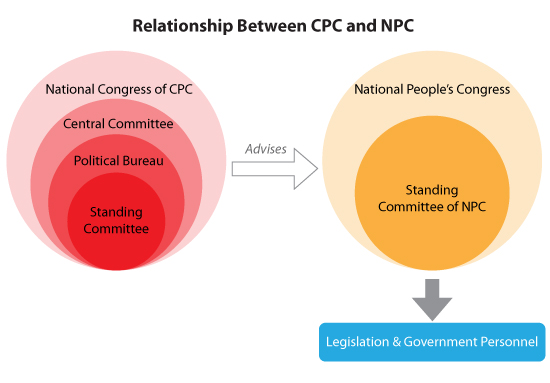Introduction to China’s Plenary Sessions and the CPC Central Committee
Nov. 11 – The Third Plenary Session (“Third Plenum”) of the 18th Central Committee of the Communist Party of China (CPC) is currently being held in Beijing from November 9th to November 12th. To understand the significance of the Third Plenum – the first since President Xi Jinping took office – it is necessary to understand the historical significance of the CPC, the Central Committee, and Third Plenary Sessions.
What are the Plenary Sessions of the CPC’s Central Committee?
The National Congress of the CPC, distinct from the National People’s Congress, is a party conference held every five years and attended by regional party representatives. Lasting 10 to 15 days, the National Congress of the CPC makes decisions regarding broader economic and political issues, and elects the members of the Central Committee—the party’s highest decision-making body.
Exercising the power of the National Congress through Plenary Sessions held at least once a year until the convening of the next National Congress, the Central Committee is charged with executing decisions confirmed during the National Congress of the CPC. After being appointed to the Central Committee, members are often placed in significant positions in China’s central or local government.
Generally, the term of each Central Committee is five years (limited to two consecutive terms), and the Political Bureau of each Central Committee leads, conventionally, seven plenary sessions in total during their five-year tenure. The Third Plenum of each Central Committee, especially when there is a recent change in the country’s leadership, is often the time for revealing massive changes in economic policy and the launching of political reforms.
The Political Bureau (or Politburo), a facet of the Central Committee, meets more frequently than the Central Committee and makes decisions regarding more short-term, day-to-day affairs. Drawn from members of the Central Committee, the Political Bureau can be further divided into the Standing Committee—composed of the highest-ranking members of the Political Bureau who are chosen during the Plenary Sessions of the Central Committee.
The members of the Standing Committee hold first-level leadership positions within both the CPC and the country, and other members of the Political Bureau hold second or third level positions. For example, the current President of China Xi Jinping is also the head of CPC (the General Secretary) and a member of the Standing Committee. Other members of the current Standing Committee include Premier Li Keqiang and the Chairman of the current National People’s Congress Zhang Dejiang.

What are the general functions of each Plenary Session?
First Plenum
- Electing members of the Political Bureau, its Standing Committee, and the head of CPC
Second Plenum
- Proposing the list of candidates for the leadership personnel of the state government and the National Committee of the Chinese People’s Political Consultative Conference (China’s top political advisory body) to the National People’s Congress
Third Plenum
- Introducing the new leadership’s broad economic and political reforms
Fourth Plenum
- Discussing further improvements to the CPC’s governing capacity
Fifth Plenum
- Introducing the next Five-Year Plan for China’s social and economic development
Sixth Plenum
- Discussing improvements in the general morality of society and CPC in addition to cultural reforms
Seventh Plenum
- Discussing the work report drafted by the Political Bureau, distributed to the next National People’s Congress, and the time for the next National Congress of the CPC
Why is the Third Plenum this year so significant?
Each time China experiences a change in leadership, the Third Plenums serve as an indication of how the country will be led for the next decade. Recent hype built around this Third Plenum anticipates, according to senior party officials quoted in the People’s Daily, the launching of “a comprehensive reform plan… its scope and impact unprecedented.”
There have been two particularly significant Third Plenums in the history of the People’s Republic of China: the 1978 Third Plenum of the 11th Central Committee, and the 14th in 1993. The 1978 Third Plenum, held two years after the death of Chairman Mao Zedong, ended the Cultural Revolution and launched the “reform and opening up of China” under Deng Xiaoping. The 1993 Third Plenum, held under Jiang Zemin, set the stage for China’s transition to a socialist market economy and led to more aggressive economic reforms promoted by Zhu Rongji.
The current Central Committee led by President Xi Jinping and Premier Li Keqiang has demonstrated a determination to push through further economic reforms by presenting a more “man-of-the-people” style agenda – a series of new policies intended to provide a boost to the Chinese market. Their so-called “383 Scheme” provides a potential roadmap for a much more open and market-oriented China via a trio of reforms aimed at opening up the market, transforming the government, and reforming enterprises to boost innovation. There is no doubt that this Third Plenum will change the course of the Chinese economy – the only question is how dramatic the changes will be.
As this Third Plenum is a four-day closed-door meeting, there has been no live coverage so far and all closed-door proceedings are reported indirectly by the media. However, a final communiqué on what has been agreed upon during this plenum will be released by the State’s official news agency Xinhua on November 12.
You can stay up to date with the latest business and investment trends across China by subscribing to Asia Briefing’s complimentary update service featuring news, commentary, guides, and multimedia resources.
- Previous Article China to Ease Company Registration Rules for Foreign Companies
- Next Article Foreigner Participation in China’s Social Insurance System




























